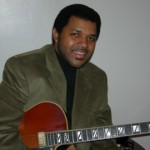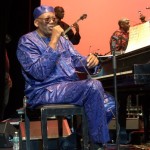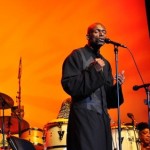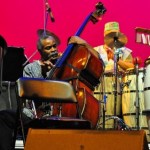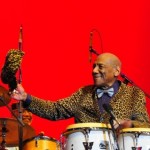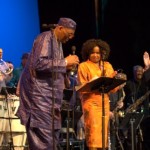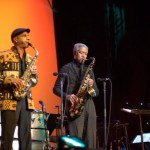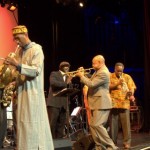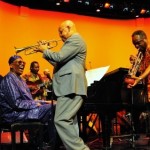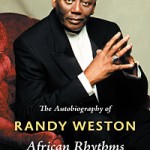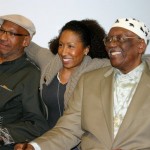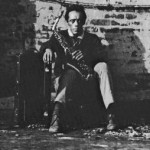Guitarist-educator, and now author, Pascal (Bokar) Thiam aims to broaden the historical timeline of blues and jazz well beyond the romantic notion of ‘up the Mississippi from New Orleans…’ Though I had the pleasure of spinning Pascal’s in-performance ’07 CD Savannah Jazz Club on radio, I didn’t have the opportunity to meet him until about two months ago at the first in a series of book signing & reading events for African Rhythms: the autobiography of Randy Weston (Composed by Randy Weston, Arranged by Willard Jenkins; Duke University Press) at Eso Won Books in L.A. It was then that the very modest, scholarly Mr. Thiam laid a copy of his book From Timbuktu to the Mississippi Delta (pub: Cognella) on me. Right from the jump the book is impressive if only for its richly illustrated design. The book’s premise and subsequent text are even more impressive.
Pascal (Bokar) Thiam was born in Paris and raised in Segou, Mali and later Dakar, Senegal. His parents immersed him in the music of such favorites of theirs as the MJQ, Nat Cole, and Sonny Rollins from an early age. He initially took up the piano at age 8, switching forevermore to the guitar at 12. While at a military school he became indelibly drawn to a career in music, eventually performing in France and Senegal extensively with the Afro fusion band Akwaaba.
In ’80, on a floating jazz festival at sea he met a number of jazz greats and became further immersed in the music, which eventually led him to study at Berklee in ’83, where he earned honors and rubbed shoulders with classmates who comprise a healthy slice of the 21st century jazz vanguard, including Branford Marsalis, Cyrus Chestnut, Greg Osby, Jeff “Tain” Watts, Antonio Hart, and Jacky Terrasson.
In ’99, following several very fruitful engagements, including his successful incorporation of a Senegalese Sabar rhythm section in his jazz pursuits and a relationship with Accurate Records, Pascal relocated to the San Francisco Bay Area. He currently teaches jazz and world music at the University of San Francisco and operates his Savannah Jazz Club.
On the subject of his powerful and revealing new book From Timbuktu to the Mississippi Delta (Cognella), obviously some questions were in order.
 Pascal (Bokar) Thiam’s illuminating book From Timbuktu to the Mississippi Delta
Pascal (Bokar) Thiam’s illuminating book From Timbuktu to the Mississippi Delta
How and when did jazz and blues become such passions for a Senegalese man?
Pascal (Bokar) Thiam: I have two explanations. Let me start by saying that this music some call Jazz is a passion for all West Africans because we can intuitively feel the extension of our standards of aesthetics across the Atlantic Ocean in the social and musical expressions of the journey of our African family through the Atlantic Slave Trade. This music of the Americas is part of the larger West African story. It is a testimony to our resilience as a people, a testimony to our genius as a community, a testimony to our faith in God as a nation and belief that the ancestors will always show us the way… “through many dangers, toils and snares we shall overcome”; that is one of the very early gospel lyrics.
When you listen attentively to the Sabar drum of Senegal [editor’s note: check out the master of that drum, Dou Dou N’diaye Rose] and become familiar with the West African traditional music of the kora of the Soundiata Keita era and the improvisational systems of the balafon, the ngoni [ed. note: an African member of the lute family] and/or xaalam, it becomes apparent to you as a listener that the core of African American music as expressed through the rural Blues, through the Jazz improvisational conceptualization, its sense of swing and syncopation, its call and response mechanisms, its bent tonalities, its harmonic 7th and sharp nine sensibilities… all of which are present in the traditional music of West African Culture, there would be no Jazz. It is as simple as that. Listening to traditional West African music drives you naturally to appreciate the rural Blues which are born out of the social experiences of West Africans in the Mississippi Delta and the South, and the African American Baptist Church socio-cultural foundation for Jazz and its sensibilities.
I love the sound of the kora, and as you know, West Africa has a powerful culture of string instruments, and so around age 12 I started playing guitar. Once you start listening to guitarists in the various musical idioms you can’t but be struck by the mastery of some artists regardless of where they live. In West Africa they were Sekou Diabate, Kante and Manfila, Franco; in the U.S.A. Albert King, Robert Johnson, John Lee Hooker, B.B. King, Jimi Hendrix, Charlie Christian, Wes Montgomery, George Benson; in Classical styles Andres Segovia, Henry Dorigny, Alexandre Lagoya, Paco de Lucia, etc. But the guitarists that came closest to my musical sensibilities were African and African American, and so I embarked upon the journey that led me to appreciate this idiom called Jazz.
It is clear and no one denies that Jazz as we understand it today, with the trap drumset, the upright bass, etc. developed in the United States and was created in the United States. But what we as a nation in the U.S. fail to state clearly (mostly to appease European Americans who today desperately want to have played an important role in the making of the art form that defined the genius and the identity of our nation’s people and music, music which until the mid 40s they themselves called “Jungle Music”; the same European American intellectual and artistic community who denied Ellington the Pulitzer Prize) is that the standards of aesthetics and the culture that gave birth to these standards of aesthetics that govern the music of the Delta Blues, Soul, Jazz, etc. ’till this day are standards of aesthetics that emanated from the civilizational cultural paradigms of the 3 empires: Ghana, Mali, and Songhai, empires which ruled civilizations in West Africa and the world from the 5th century until the 18th, and centered in Timbuktu on the Niger River. These populations from West Africa settled the New World.
The second reason is more a theory and I firmly believe it. I was born in Paris at a time when my parents were hanging out in the Jazz clubs of Saint Germain. My dad was one of the first generation of young Africans to obtain a scholarship to go to college in Paris, and this is an age when you usually meet your wife. My dad loved Jazz. He was at school during the day and in the Jazz clubs at night. He met Dizzy, Miles, and Kenny Clarke in Paris in the late fifties and early sixties, along with Dexter Gordon, Buhaina and so many others. My theory is that when I was in my mother’s womb and unable to escape I was listening to Jazz whether I liked it or not and the sound wave frequencies of the music, its swing and syncopation, harmonic and tonal colors stayed in the back of my cortex as I was developing. So in many ways my direction was pre-ordained, so to speak. Shortly after I was born we moved to the magical place of Segou, Mali where the spirits congregate and where I still have a significant amount of family. I used to put my feet in the Niger River under the watchful eye of my parents when I was a walking baby. It is a dangerous river with lots of crocodiles.
My passion for Jazz and Blues was born out of the fact that these art forms require a phenomenal balance of intellect, creativity, sensibility and soul and I embraced the challenge because I realized through Jazz, how high and complex the standards of aesthetics were in this process of spontaneous creativity from an African perspective of art.
Ultimately I came to realize that there is an intellectual content, and unity of soul and perspective in all African-derived art forms. This is what Senghor referred to as the civilization of the Universal with Africa and African aesthetics at the center of that intuitive, creative, rhythmic flow-inferred universe. Whether I play Senegalese music, or the Malian repertoire, country music or the music of Gillespie or Parker, the roots of expression and improvisational core systems are the same. The accents on the rhythms in their relationship to the cosmic rhythmic flow of our humanity, whether tonal or syncopated in convergence with its rotating planets, are the same.
The soul principles of the African rhythmic balance of our lives as we improvise, regardless of the musical medium, is in the hermeneutic interplay of three against two as a referential starting point. It’s all the same concepts of balance. There is unity of principles in action, which is why America’s foremost composer, Edward Kennedy Ellington, stated for all of us something that we deeply feel in West Africa and that he translated in his famous title “It don’t mean a thing if it ain’t got that…”
How are you able to juggle your many pursuits, from playing the guitar to operating a club, to teaching, to writing your book?
I am doing very poorly at juggling, I need a lot of help, and I am very fortunate to have [wife] Vicki and partners, close friends and staff members who do a wonderful job a keeping the train on the tracks. The book took longer that I wanted because I was looking for a collaboration but my other pals in academia were too busy with their own projects. So I decided to write it myself because the ancestors probably decided that time was of the essence.
Talk about your club; how and when you developed it and what you hope to achieve with this venue.
As an African living in America, I opened the Club with Vicki and her sister (both of whom are teachers) because I realized that we as a community in the U.S. were losing the cultural war as we lost the Clubs through the so-called process of “integration.” The music venues, which were so important in the African American community as civilizational and community unifying centers where art could flourish and standards of expression could live long enough to gain refinement, disappeared. Africans have always had extremely high standards of aesthetics when it came to expression and refinement in every endeavor that we conduct. You hear it in the music of the kofa and the balafon, in Charlie Parker playing “Laura”, in Miles playing “My Funny Valentine”, in the craftsmanship of our blacksmiths, in the designs of our sculptors; that’s what we do, that’s what we embrace as a collective when we can take the time to breathe, to gather our thoughts and ourselves. But we are in the midst of a brutal economic, political and academic oppression and it is getting harder and harder for us to teach our young people the ways and the values of the ancestors. That is why our young people don’t understand how far down as a community we fell in the assessment of our aesthetics under capitalism.
As an educator, I am sick to my stomach when I see how academia, show business, and simply business entities have in tandem stolen the music, the art forms, and distorted the contributions of people of African descent in this country. Why do books continue to call Paul Whiteman the “King” of a music he barely understood when James Reese Europe, King Oliver, Buddy Bolden, Armstrong and Ellington had already codified its principles?
Why is academia continuing to print that Benny Goodman is the “King” of a music he himself never conceptualized? It took John Hammond, a Vanderbilt, going up to Harlem to purchase the book of the Father of Big Band writing, Fletcher Henderson, for Goodman’s career to take off. As for the other European American “King” of the music of Chuck Berry, that is another falsehood that academia in America continues to perpetrate and project into our young African and European American generations. So it is no wonder that our African American children feel disconnected and walk around with their pants down, with no sense of their ancestors’ legacies, which are enormous and have lifted this nation to the status of a civilizational super-power. Where is academia to redress these falsehoods? Baldwin said it best a long time ago, something to the effect that “it took my grandfather and grandmother’s time, my father and my mother’s time, my nephews and my niece’s time; how long will it take for your progress?”
Why do we in America continue to fund and worship the classical music of Vienna and Italy, Paris and Bonn, when we do not even bother to teach our children in elementary, middle, and high school curriculum about the revolutionary music of our own American musicians: Armstrong, Ellington, James Reese Europe, Henderson, Chuck Berry, Little Richard, Parker, Gillespie, etc., musicians who have single-handedly disrupted all European musical standards to the point where young European musicians from Clapton to John Mayall, the Beatles to the Who, Led Zeppelin to the Stones, etc…. are collectively mostly playing American or American-influenced popular musics born out of the Blues of the South of our nation?
So as a result and thanks to a ruthless economic system, in fifty years we went from Ellington, Armstrong, Reese Europe, Tatum, and King Oliver… people who raised America’s standards of aesthetics to new heights that gave America the status of a civilizational super-power that the world over-emulated, to being portrayed with our pants down to our ankles, underwear showing, with inappropriate language skills, incable of high aesthetics, portrayed as buffoons all over the planet through these despicable cable channels that delight in projecting these debilitating images of Black people, images born out of the despair engendered by the economic oppression and the legacy of slavery, Jim Crow and academic and political oppression.
It hurts me as an educator to see the negative impact that our economic, judicial and education systems have had on our communities; systems we do not control thus are subjected to. I often tell my students, when you see artists who called themselves “Duke” Ellington, “Count” Basie, Nat “King” Cole… these titles they gave themselves were in direct relationship to their commitment to their art form. Today, when I hear the titles you give yourselves – “Pimp this”, Gangsta that, etc… pants down the ankles, mysogynists, uneducated, verbally abusive to women… these titles are also representative of your relationship to your craft. But these are not our collective standards of aesthetics at work, these are symptoms, and the reflection of the monumental economic, political, and academic hurt inflicted on our communities as a result of this unbridled capitalism that ravages our daily lives.
I am convinced that we can and will do better as a community as we begin the process of reconstructing an image and an ideal that suits our sensibilities and heals our family structures.
Stay tuned for Pt. 2 with Pascal (Bokar) Thiam, when he discusses his book From Timbuktu to the Mississippi Delta.

